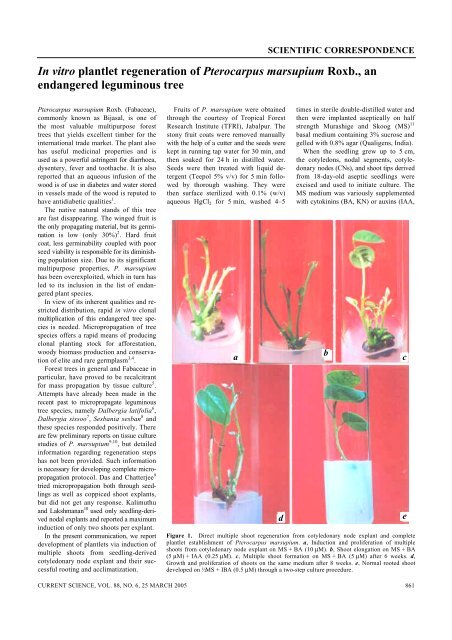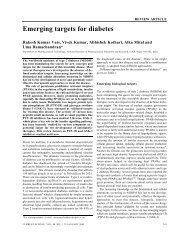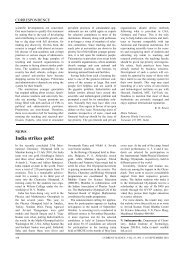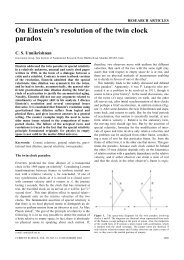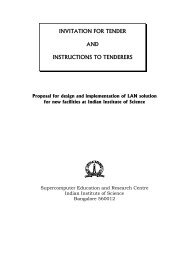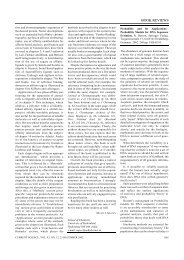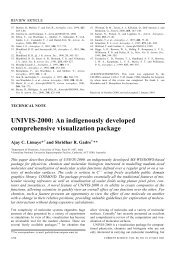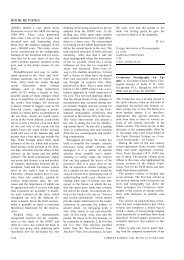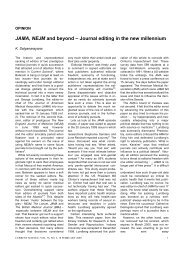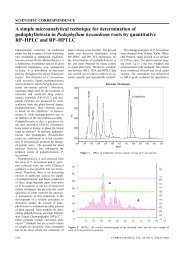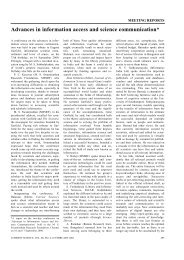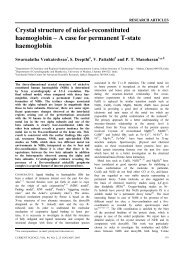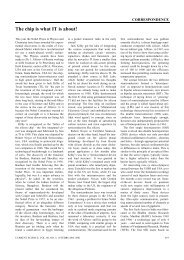In vitro plantlet regeneration of Pterocarpus marsupium Roxb ... - IISc
In vitro plantlet regeneration of Pterocarpus marsupium Roxb ... - IISc
In vitro plantlet regeneration of Pterocarpus marsupium Roxb ... - IISc
Create successful ePaper yourself
Turn your PDF publications into a flip-book with our unique Google optimized e-Paper software.
SCIENTIFIC CORRESPONDENCE<br />
<strong>In</strong> <strong>vitro</strong> <strong>plantlet</strong> <strong>regeneration</strong> <strong>of</strong> <strong>Pterocarpus</strong> <strong>marsupium</strong> <strong>Roxb</strong>., an<br />
endangered leguminous tree<br />
<strong>Pterocarpus</strong> <strong>marsupium</strong> <strong>Roxb</strong>. (Fabaceae),<br />
commonly known as Bijasal, is one <strong>of</strong><br />
the most valuable multipurpose forest<br />
trees that yields excellent timber for the<br />
international trade market. The plant also<br />
has useful medicinal properties and is<br />
used as a powerful astringent for diarrhoea,<br />
dysentery, fever and toothache. It is also<br />
reported that an aqueous infusion <strong>of</strong> the<br />
wood is <strong>of</strong> use in diabetes and water stored<br />
in vessels made <strong>of</strong> the wood is reputed to<br />
have antidiabetic qualities 1 .<br />
The native natural stands <strong>of</strong> this tree<br />
are fast disappearing. The winged fruit is<br />
the only propagating material, but its germination<br />
is low (only 30%) 2 . Hard fruit<br />
coat, less germinability coupled with poor<br />
seed viability is responsible for its diminishing<br />
population size. Due to its significant<br />
multipurpose properties, P. <strong>marsupium</strong><br />
has been overexploited, which in turn has<br />
led to its inclusion in the list <strong>of</strong> endangered<br />
plant species.<br />
<strong>In</strong> view <strong>of</strong> its inherent qualities and restricted<br />
distribution, rapid in <strong>vitro</strong> clonal<br />
multiplication <strong>of</strong> this endangered tree species<br />
is needed. Micropropagation <strong>of</strong> tree<br />
species <strong>of</strong>fers a rapid means <strong>of</strong> producing<br />
clonal planting stock for afforestation,<br />
woody biomass production and conservation<br />
<strong>of</strong> elite and rare germplasm 3,4 .<br />
Forest trees in general and Fabaceae in<br />
particular, have proved to be recalcitrant<br />
for mass propagation by tissue culture 5 .<br />
Attempts have already been made in the<br />
recent past to micropropagate leguminous<br />
tree species, namely Dalbergia latifolia 6 ,<br />
Dalbergia sissoo 7 , Sesbania sesban 8 and<br />
these species responded positively. There<br />
are few preliminary reports on tissue culture<br />
studies <strong>of</strong> P. <strong>marsupium</strong> 9,10 , but detailed<br />
information regarding <strong>regeneration</strong> steps<br />
has not been provided. Such information<br />
is necessary for developing complete micropropagation<br />
protocol. Das and Chatterjee 9<br />
tried micropropagation both through seedlings<br />
as well as coppiced shoot explants,<br />
but did not get any response. Kalimuthu<br />
and Lakshmanan 10 used only seedling-derived<br />
nodal explants and reported a maximum<br />
induction <strong>of</strong> only two shoots per explant.<br />
<strong>In</strong> the present communication, we report<br />
development <strong>of</strong> <strong>plantlet</strong>s via induction <strong>of</strong><br />
multiple shoots from seedling-derived<br />
cotyledonary node explant and their successful<br />
rooting and acclimatization.<br />
Fruits <strong>of</strong> P. <strong>marsupium</strong> were obtained<br />
through the courtesy <strong>of</strong> Tropical Forest<br />
Research <strong>In</strong>stitute (TFRI), Jabalpur. The<br />
stony fruit coats were removed manually<br />
with the help <strong>of</strong> a cutter and the seeds were<br />
kept in running tap water for 30 min, and<br />
then soaked for 24 h in distilled water.<br />
Seeds were then treated with liquid detergent<br />
(Teepol 5% v/v) for 5 min followed<br />
by thorough washing. They were<br />
then surface sterilized with 0.1% (w/v)<br />
aqueous HgCl 2 for 5 min, washed 4–5<br />
a<br />
d<br />
times in sterile double-distilled water and<br />
then were implanted aseptically on half<br />
strength Murashige and Skoog (MS) 11<br />
basal medium containing 3% sucrose and<br />
gelled with 0.8% agar (Qualigens, <strong>In</strong>dia).<br />
When the seedling grew up to 5 cm,<br />
the cotyledons, nodal segments, cotyledonary<br />
nodes (CNs), and shoot tips derived<br />
from 18-day-old aseptic seedlings were<br />
excised and used to initiate culture. The<br />
MS medium was variously supplemented<br />
with cytokinins (BA, KN) or auxins (IAA,<br />
Figure 1. Direct multiple shoot <strong>regeneration</strong> from cotyledonary node explant and complete<br />
<strong>plantlet</strong> establishment <strong>of</strong> <strong>Pterocarpus</strong> <strong>marsupium</strong>. a, <strong>In</strong>duction and proliferation <strong>of</strong> multiple<br />
shoots from cotyledonary node explant on MS + BA (10 µM). b, Shoot elongation on MS + BA<br />
(5 µM) + IAA (0.25 µM). c, Multiple shoot formation on MS + BA (5 µM) after 6 weeks. d,<br />
Growth and proliferation <strong>of</strong> shoots on the same medium after 8 weeks. e, Normal rooted shoot<br />
developed on ½MS + IBA (0.5 µM) through a two-step culture procedure.<br />
b<br />
c<br />
e<br />
CURRENT SCIENCE, VOL. 88, NO. 6, 25 MARCH 2005 861
SCIENTIFIC CORRESPONDENCE<br />
Table 1.<br />
Effect <strong>of</strong> cytokinin on shoot proliferation from cotyledonary nodes <strong>of</strong> <strong>Pterocarpus</strong> <strong>marsupium</strong> in MS medium<br />
Percentage explants Mean number <strong>of</strong> shoots Mean length <strong>of</strong> shoots<br />
Growth regulator showing shoot proliferation produced/explant (mm)<br />
BA (1.0 µM) 40 1.16 ± 0.17 cd 21.2 ± 0.03 c<br />
BA (2.5 µM) 60 2.00 ± 0.26 c 15.6 ± 0.04 d<br />
BA (5.0 µM) 85 7.83 ± 0.30 a 54.3 ± 0.04 a<br />
BA (10 µM) 70 4.66 ± 0.21 b 37.8 ± 0.05 b<br />
Kn (1.0 µM) 30 0.33 ± 0.21 d 7.3 ± 0.03 f<br />
Kn (2.5 µM) 50 0.66 ± 0.21 d 8.0 ± 0.06 d<br />
Kn (5.0 µM) 55 0.83 ± 0.17 d 12.5 ± 0.05 e<br />
Kn (10 µM) 40 0.50 ± 0.22 d 7.4 ± 0.03 b<br />
Values represent mean ± SE <strong>of</strong> ten replicates per treatment.<br />
Mean values within the column followed by the same letter are not significantly different by the Tukey’s test at 0.05%<br />
probability level.<br />
Table 2.<br />
Effect <strong>of</strong> IAA/NAA with optimal concentration <strong>of</strong> BA on shoot proliferation from cotyledonary nodes<br />
<strong>of</strong> P. <strong>marsupium</strong> in MS medium<br />
Percentage explants showing Mean number <strong>of</strong> shoots Mean length<br />
Composition shoot proliferation produced/explant <strong>of</strong> shoots (mm)<br />
BA (5 µM) + IAA (0.25 µM) 70 4.16 ± 0.30 a 40.1 ± 0.06 a<br />
BA (5 µM) + IAA (0.50 µM) 60 1.33 ± 0.21 b 16.7 ± 0.03 b<br />
BA (5 µM) + IAA (1.00 µM) 50 1.00 ± 0.25 bc 10.6 ± 0.3 bc<br />
BA (5 µM) + NAA (0.25 µM) 50 0.50 ± 0.22 bc 7.5 ± 0.25 cd<br />
BA (5 µM) + NAA (0.50 µM) 30 0.33 ± 0.21 bc 5.6 ± 0.18 cd<br />
BA (5 µM) + NAA (1.00 µM) 30 0.20 ± 0.16 bc 0.38 ± 0.19 d<br />
Values represent mean ± SE <strong>of</strong> ten replicates per treatment.<br />
Mean values within the column followed by the same letter are not significantly different by the Tukey’s test at<br />
0.05% probability level.<br />
IBA, NAA), either singly or in combination.<br />
The pH <strong>of</strong> the medium was adjusted<br />
to 5.8 before autoclaving at 121°C for<br />
20 min. Borosil test tubes containing 15 ml<br />
<strong>of</strong> the medium were used, covered with<br />
cotton plugs wrapped in cheese cloth. All<br />
cultures were incubated at 25 ± 2°C in a<br />
photoperiod <strong>of</strong> 16 h for a day under fluorescent<br />
light (about 1200 lux) and with<br />
55–60% relative humidity.<br />
<strong>In</strong> <strong>vitro</strong> differentiated shoots measuring<br />
3–4 cm were excised and subjected to in<br />
<strong>vitro</strong> rooting. For rooting, half and full<br />
strength MS medium augmented with<br />
various auxins (IAA, IBA, NAA) along<br />
with a phenolic acid were used.<br />
All experiments were repeated thrice and<br />
ten replicates per treatment were taken. The<br />
data were analysed using one way analysis<br />
<strong>of</strong> variance (ANOVA) followed by Tukey’s<br />
test with a confidence limit <strong>of</strong> 0.05.<br />
Among various explants used, CN<br />
showed excellent response. The CN explants<br />
inoculated on MS medium responded differently<br />
to various cytokinins singly or in<br />
combination (Table 1). Among different<br />
concentrations <strong>of</strong> cytokinin tested, maximum<br />
shoot multiplication (7.83 ± 0.30)<br />
per explant was achieved on MS medium<br />
fortified with BA (5 µM) within 6 weeks<br />
(Figure 1 c). Multiple shoots obtained<br />
were divided into 2–3 clumps for further<br />
proliferation and to increase the number<br />
<strong>of</strong> shoots. These in turn proliferated into<br />
multiple shoots on the same concentration<br />
<strong>of</strong> BA (Figure 1 d). Regular subculturing<br />
was done every 3–4 weeks onto<br />
fresh medium. During initial subculturing,<br />
the mother explant was kept intact with<br />
proliferated shoots. <strong>In</strong>creasing the concentration<br />
<strong>of</strong> BA (10 µM) resulted in a decrease<br />
in the rate <strong>of</strong> shoot <strong>regeneration</strong> ability.<br />
Only 4.66 ± 0.21 shoots could be recorded<br />
after 6 weeks (Figure 1 a). <strong>In</strong>hibitory effect<br />
<strong>of</strong> higher concentrations <strong>of</strong> BA on shoot<br />
formation has also been reported in Albizia<br />
chinensis 12 .<br />
When kinetin was used as the sole cytokinin<br />
(1.0–10 µM), only elongation <strong>of</strong><br />
single shoot took place and no significant<br />
response was observed. Explants grown<br />
on BA-supplemented medium showed better<br />
growth and elongation, and were found<br />
to be more responsive to BA than kinetin.<br />
BA-induced shoot proliferation from<br />
CNs has also been reported in Dalbergia<br />
sissoo 13 and A. chinensis 12 . Superiority<br />
<strong>of</strong> BA for induced shoot multiplication in<br />
<strong>Pterocarpus</strong> species 14,15 has also been<br />
reported earlier.<br />
Using BA (5 µM) as optimum for maximum<br />
shoot bud induction, different auxins<br />
(IAA and NAA) at 0.25–1.0 µM were<br />
added to the medium along with BA to<br />
observe the synergistic effect <strong>of</strong> auxin<br />
and cytokinin. Low level <strong>of</strong> IAA (0.25 µM)<br />
showed the effect on shoot bud induction,<br />
while higher levels (0.5–1.0 µM) were not<br />
found beneficial, as the callus was observed<br />
at the base <strong>of</strong> the explant. A maximum<br />
<strong>of</strong> 4.16 ± 0.75 shoots per explant were<br />
differentiated on MS medium supplemented<br />
with BA (5 µM) and IAA (0.25 µM)<br />
within 5–6 weeks (Figure 1 b). However,<br />
on BA (5 µM) + NAA (0.25–1.0 µM) supplemented<br />
medium, no significant results<br />
were observed (Table 2).<br />
The addition <strong>of</strong> IAA and NAA with<br />
optimal concentration <strong>of</strong> BA significantly<br />
reduced the frequency <strong>of</strong> shoot formation<br />
compared to BA alone. This is in contrast<br />
with the result reported in Wrightia tinctoria<br />
16 and Acacia catechu 17 , where maximum<br />
number <strong>of</strong> shoot buds were initiated<br />
in the BA and NAA combination.<br />
Healthy and sturdy shoots (4–5 cm<br />
long) were transferred to rooting medium<br />
862<br />
CURRENT SCIENCE, VOL. 88, NO. 6, 25 MARCH 2005
SCIENTIFIC CORRESPONDENCE<br />
Figure 2. Established <strong>plantlet</strong> after 8 weeks<br />
under ex <strong>vitro</strong> conditions.<br />
containing different concentrations <strong>of</strong> MS<br />
salts (¼, ½ and full strength) and different<br />
auxins (IAA, IBA and NAA) applied<br />
singly at various concentrations. After 3–<br />
4 weeks <strong>of</strong> incubation, no rooting took<br />
place and callusing was observed at the base<br />
<strong>of</strong> the shoots.<br />
The isolated microshoots were rooted<br />
to 40–50% success in 15–17 days by the<br />
two-step culture procedure and using a<br />
strategy <strong>of</strong> giving pulse treatment <strong>of</strong> an<br />
auxin (IBA; 200 µM) together with a<br />
phenolic acid for 5 days and subsequent<br />
transfer <strong>of</strong> such shoots to lower concentration<br />
<strong>of</strong> auxin IBA (0.5 µM) on ½ MS<br />
medium. A single thick root induction<br />
was observed (Figure 1 e). The requirement<br />
<strong>of</strong> half strength culture medium for<br />
in <strong>vitro</strong> rooting has been reported in<br />
many woody species 18,19 . The two-step<br />
culture procedure for rooting was also<br />
reported in Albizia 12 . The incorporation<br />
<strong>of</strong> an auxin in the medium generally promotes<br />
rooting, while in the present study<br />
auxin alone in the MS medium was found to<br />
be ineffective for rooting. This is contrary<br />
to an earlier report, where IAA alone promoted<br />
rooting in P. <strong>marsupium</strong> 15 . However,<br />
addition <strong>of</strong> IBA with a phenolic<br />
acid for root initiation has also been demonstrated<br />
in Apple 20 , Mallotus philippensis<br />
21 and Shorea robusta 22 .<br />
Thus, eight to nine true-to-type <strong>plantlet</strong>s<br />
<strong>of</strong> P. <strong>marsupium</strong> were raised in <strong>vitro</strong> from<br />
single cotyledonary node explant, transferred<br />
to perforated paper cups for gradual<br />
acclimatization and irrigated with nutrient<br />
solution every alternate day (Figure<br />
2). Regenerated <strong>plantlet</strong>s are in the<br />
hardening process.<br />
Thus, our results indicate the direct <strong>regeneration</strong><br />
<strong>of</strong> multiple shoots from CN<br />
explants <strong>of</strong> this endangered legume tree.<br />
Direct <strong>regeneration</strong> from the CN explants<br />
will ensure the cloning stocks 4 <strong>of</strong> this<br />
valuable tree. Reproducibility and <strong>plantlet</strong><br />
<strong>regeneration</strong> will surely lead to the use <strong>of</strong><br />
this system in afforestation programmes.<br />
1. Anon, <strong>In</strong> Wealth <strong>of</strong> <strong>In</strong>dia, 2003, vol.<br />
VIII, pp. 302–305.<br />
2. Kalimuthu, K. and Lakshmanan, K. K.,<br />
<strong>In</strong>dian J. For., 1995, 18, 104–106.<br />
3. Bonga, J. M., <strong>In</strong> Tissue Culture in Forestry<br />
(eds Bonga, J. M. and Durzan, D.<br />
J.), Martinus Nijh<strong>of</strong>f Publishers,<br />
Dordrecht, 1987, vol. 1, pp. 249–271.<br />
4. Bajaj, Y. P. S., <strong>In</strong> Biotechnology in Agriculture<br />
and Forestry 1, Trees I (ed. Bajaj,<br />
Y. P. S.), Springer-Verlag, Berlin,<br />
1986, pp. 1–23.<br />
5. Lakshmi Sita, G., Sreenatha, K. S. and<br />
Sujata, S., Curr. Sci., 1992, 62, 532–534.<br />
6. Rhagava Swamy, B. V., Himabindu, K.<br />
and Sita, G. L., Plant Cell Rep., 1992,<br />
11, 126–131.<br />
7. Gulati, A. and Jaiwal, P. K., Biol. Plant.,<br />
1996, 38, 169–175.<br />
8. Shanker, S. and Mohan Ram, H. Y., Phytomorphology,<br />
1990, 40, 45–32.<br />
9. Das, T. and Chatterjee, A., <strong>In</strong>dian J.<br />
Plant Physiol., 1993, 24, 269–272.<br />
10. Kalimuthu, K. and Lakshmanan, K. K.,<br />
<strong>In</strong>dian J. For., 1994, 19, 192–195.<br />
11. Murashige, T. and Skoog, F., Physiol.<br />
Plant., 1962, 15, 473–497.<br />
12. Sinha, R. K., Majumdar, K. and Sinha,<br />
S., <strong>In</strong> Vitro Cell. Dev. Biol.–Plant, 2000,<br />
36, 370–373.<br />
13. Pradhan, C., Kar, S., Pattnaik, S. and<br />
Chand, P. K., Plant Cell Rep., 1998, 18,<br />
122–126.<br />
14. Patri, S., Bhatnagar, S. P. and Bhojwani,<br />
S. S., Phytomorphology, 1988, 38, 41–45.<br />
15. Anuradha, M. and Pulliah, T., Phytomorphology,<br />
1999, 49, 157–163.<br />
16. Purohit, S. D., Kukda. G., Sharma, P. and<br />
Tak, K., Plant Sci., 1994, 103, 67–72.<br />
17. Kaur, K., Verma, B. and Kant, U., Plant<br />
Cell Rep., 1998, 17, 427–429.<br />
18. Tang, D., Tshil, K. and Ohbak, Plant<br />
Cell Rep., 1996, 15, 658–661.<br />
19. Thakur, M., Sharma, D. R. and Kanwar,<br />
K., Phytomorphology, 2001, 51, 123–<br />
127.<br />
20. James, D. J., Knight, V. H. and Thurbon,<br />
I. J., Sci. Hortic., 1980, 12, 313–319.<br />
21. Sehgal, C. B. and Abbas, S. N., Phytomorphology,<br />
1996, 46, 283–289.<br />
22. Jain, M. and Chaturvedi, H. C., <strong>In</strong> Role <strong>of</strong><br />
Plant Tissue Culture Biodiversity Conservation<br />
Economic Development (eds<br />
Nandi, S. K., Palni, L. M. S. and Kumar,<br />
A.), Gyanodya Prakashan, Nainital,<br />
2002, pp. 73–77.<br />
ACKNOWLEDGEMENTS. We thank the<br />
Department <strong>of</strong> Biotechnology, New Delhi for<br />
financial assistance and the Director, TFRI,<br />
Jabalpur, for procurement <strong>of</strong> seed material.<br />
We also thank Dr A. K. Sharma, National Botanical<br />
Research <strong>In</strong>stitute, Lucknow for valuable<br />
suggestions.<br />
Received 31 May 2004; revised accepted 5<br />
October 2004<br />
M. ANIS*<br />
MOHD KASHIF HUSAIN<br />
ANWAR SHAHZAD<br />
Plant Tissue Culture Laboratory,<br />
Department <strong>of</strong> Botany,<br />
Aligarh Muslim University,<br />
Aligarh 202 002, <strong>In</strong>dia<br />
*For correspondence.<br />
e-mail: anism1@rediffmail.com<br />
CURRENT SCIENCE, VOL. 88, NO. 6, 25 MARCH 2005 863


